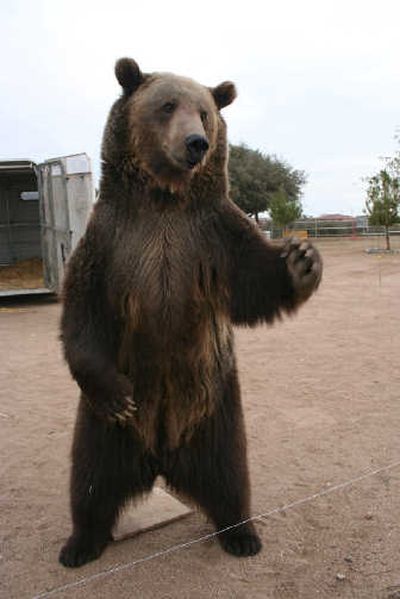Risk is part of job, animal trainers say

LOS ANGELES – By all accounts, Rocky was one of the most gentle and affectionate animals to be found in Hollywood’s vast exotic menagerie of performing lions, tigers and bears – until the day the 700-pound grizzly bit the neck of a veteran trainer and killed him.
To some animal rights activists, Stephan Miller’s death Tuesday was a tragedy waiting to happen for an industry that should be retiring wild animals in favor of computer-generated images. But to members of Hollywood’s tight-knit community of exotic animal trainers, it represented a rare but accepted hazard in an industry they insist is no more dangerous than racing cars or fighting fires.
“If it came right down to it, if the same protocols were in place, I’d wrestle the bear again,” said veteran trainer Joel Almquist, who tussled with Rocky hundreds of times as he prepared the grizzly for his scene in the movie “Semi-Pro.”
In the film, which received the American Humane Association’s “outstanding” rating for its handling of Rocky, Will Ferrell agrees to wrestle a bear to promote his semi-pro basketball team. In reality, the actor never got close to the beast, with a trainer acting as a stunt double and a person in a bear suit standing in at times for the animal.
Something went terribly wrong, however, when Miller, 39, put the bear through a similar workout at his cousin Randy Miller’s Predators in Action exotic animal compound in the mountains 100 miles north of Los Angeles. His death is being investigated by the state Department of Industrial Relations, and the bear’s fate is undetermined.
Although stressing that they weren’t there, several animal handlers and monitors insisted it must have been an accident. Almquist figures the bear simply got too excited and bit down harder than it meant to.
“Bears do nips or bites sometimes, and it’s not an aggressive thing, it’s like a get-your-attention thing,” Almquist said. “If Rocky did pinch Steve with his mouth, if he grabbed on his neck and got him in the wrong spot, that obviously could be fatal.”
That kind of risk isn’t acceptable, says Lisa Wathne, of People for the Ethical Treatment of Animals.
“We frankly are not surprised that this incident happened. No one should be surprised when a captive wild animal follows its natural instinct and shows aggression toward humans,” she said.
For PETA, of course, risk to the trainer is only part of the argument.
“These animals are trained through fear and intimidation,” she said. “They spend their lives in extreme confinement being toted from one movie set to another. They are denied everything that is natural to them.”
Hollywood animal trainers make up a small, guarded community, and several were reluctant to speak publicly about the accident this week, saying they did not want to draw the attention of animal rights groups. But they insisted privately that their film and TV work is regulated by the American Humane Association, as well as state and local authorities, and that their animals are well cared for.
“We’re not talking about some guy in Arkansas with a tiger in his yard,” said one trainer with 18 years experience who had just wrapped up a day’s television work with an elephant. “There’s only about 20 companies, and only about 14 with exotic animals, in this business. And this is pretty much the first death that I know about in our industry.”
Karen Rosa, director of the American Humane Association’s film and television unit, which oversees the care of animals on TV and movie sets, said Miller’s death is the only one she can recall in her 15 years with the organization.
Still, Wathne said, advances in technology are beginning to make it possible for Hollywood to stop using animals in favor of computer-generated images.
“Not only is it more humane for the animals, but it’s safer,” she said.
Trainers acknowledge that computers are being used more and more, but they argue that such images still look fake in close-ups.
“But with technology being what it is, every year it advances,” Oscar-winning animator Richard Taylor of “Lord of the Rings” and “King Kong” fame said. “I do think that with the advancements of technology, CGI is going to replace a number of instances where trained wild animals are needed.”